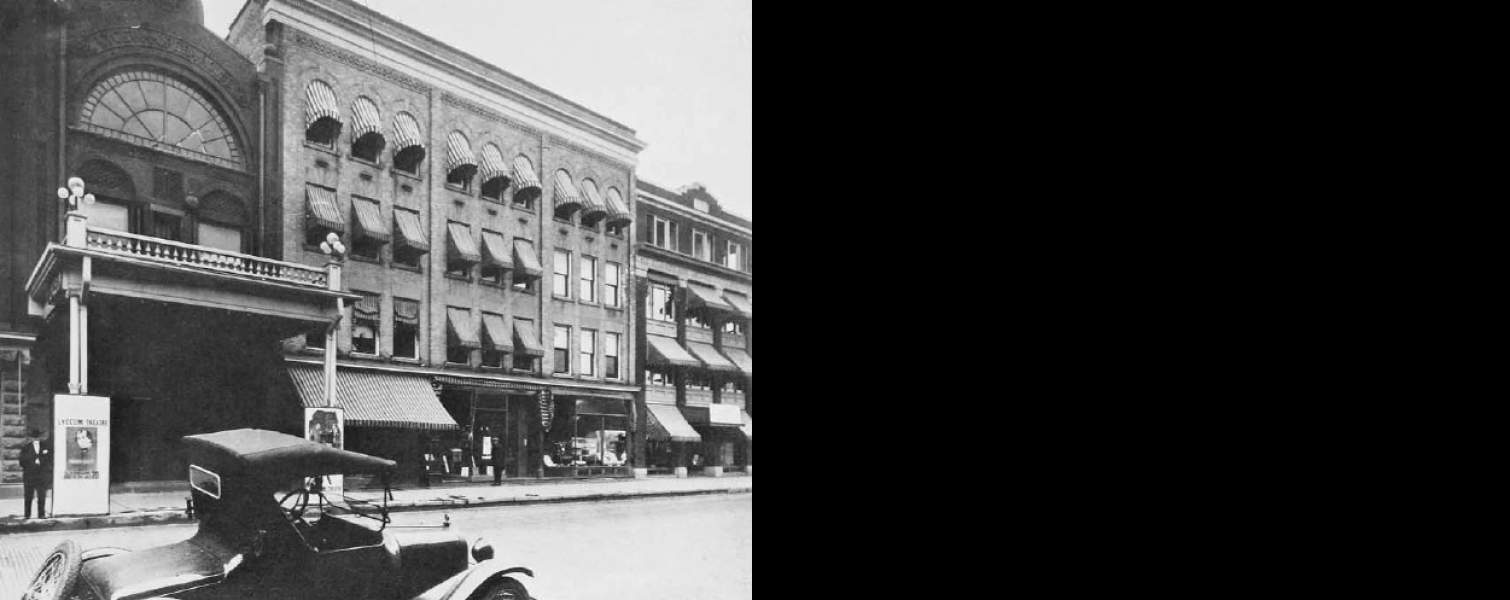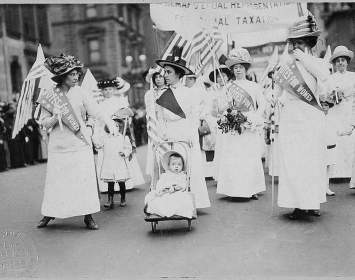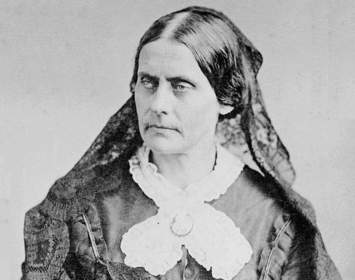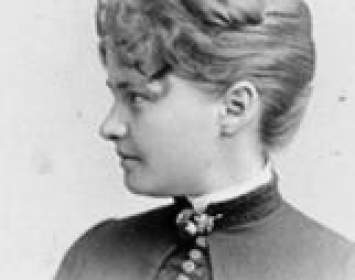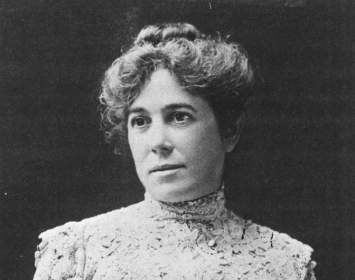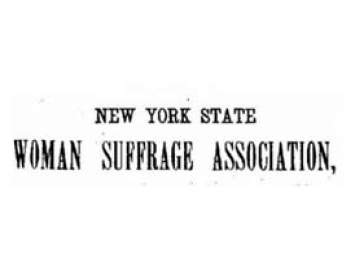The twenty-sixth annual convention of the New York State Woman Suffrage Association (NYSWSA) was held at Ithaca on Monday through Friday, November 12–16, 1894. (Nineteenth-century practice was to use the singular, woman or woman's when referring to women as a class; later practice was to use the plural, women or women's.) Public meetings were held at the Lyceum Opera House and Library Hall. The convention headquarters was the Clinton House hotel on North Cayuga Street.
The first public session was held at the Lyceum on the evening of Monday, November 12, at 7:45 p.m. A capacity crowd—which a local newspaper, the Cornell Era, referred to as “a cultured audience”—attended. Jacob Gould Schurman, then president of Cornell University, spoke warmly but faint-heartedly in favor of woman suffrage. Mayor Clinton D. Bouton greeted the delegates.
Jean Brooks Greenleaf, then president of the NYSWSA, delivered a major address. She looked back on a successful spring campaign that collected 600,000 signatures on a petition asking a New York State constitutional convention to remove language limiting the franchise to males. That petition was considered, but rejected, when the constitutional convention met in summer. Yet the suffrage movement in New York had gained organizing skills, added credibility, and even new leadership from the campaign. Greenleaf declared:
"The year closing with this convention has been one of the most momentous since the inception of the woman’s rights movement in 1848: and we feel safe in the assertion that its work well may be regarded as the beginning of the end of the great struggle for the political equality of all intelligent law abiding citizens in the state …
"In the constitutional convention our defeat was in a measure a victory. Our petition was not greeted with sneers and derision, as would have been the case thirty years ago, but it received respectful consideration from most of those participating in the discussion relative to the submission of our question to the popular vote."
Minister and woman's-rights activist Annis Ford Eastman delivered an address titled “Why the Moral Reformer Needs the Ballot,” declaring that “if women are to obey the laws, they must have an opportunity to say what those laws shall be.” Farmer, Spiritualist, and suffrage activist Carrie E. S. Twing (formally, Caroline Edna Skinner Twing) of Westfield spoke on behalf of the New York Grange. (Organized agriculture produced several noteworthy suffrage activists, of whom Twing was one.)
The proceedings of Tuesday, November 13, unfolded entirely in Library Hall. They included an election of officers in which Greenleaf was re-elected president, Harriet May Mills was elected recording secretary, and Isabel Howland was elected corresponding secretary. The evening session was standing-room-only when Susan B. Anthony delivered a major address entitled “An Historical Review.” Anthony focused largely on successes in the several mostly western states that had already enacted woman suffrage.
A business meeting opened at the Lyceum at 10:45 a.m. on Wednesday, November 14. The decision was taken that the convention should petition the state legislature to pass a woman suffrage amendment directly in 1895, when newly elected lieutenant governor and suffrage advocate Charles Terry Saxton would preside over the state Senate. (That effort, too, would be unsuccessful.)
Wednesday’s evening session at the Lyceum included a lecture titled “The Ethics of Patriotism” by Annie E. P. Searing, plus an address by Anna Howard Shaw and a second address by Twing.
On Thursday, November 15, a business meeting convened at the Lyceum at 3:00 p.m. A series of reports from county suffrage organizations around New York was concluded. Mary Stafford Anthony was honored on the occasion of completing her one-year term as corresponding secretary of the NYSWSA. (She was succeeded by Isabel Howland.) Mary was Susan B. Anthony's younger sister and an accomplished suffrage activist. She founded Rochester's Political Equality Club in 1886 and was its president from 1892 to 1904. At the business meeting, she was declared Corresponding Secretary Emeritus for life. In her remarks of thanks, Mary Anthony stated: “Let this convention be such as this state has never seen before. Let it be proved that the love of justice is neither dead nor sleeping; that politics means something higher and better than mere party success!”
Nationally prominent suffragist Lillie Devereux Blake presented the resolutions that had been advanced by the resolutions committee, which she shared.
The convention's final event was a meeting of NYSWSA's Executive Board at the Clinton House on the morning of Friday, November 16. Thirteen members attended. At the conclusion of that meeting, the twenty-sixth annual convention of the NYSWSA came to a close.
The Building and Site. Owned by three brothers—the hardware merchants and Ithaca business leaders Leonard, Lafayette, and Elias Treman (1822–1898)—and designed by the local architectural firm of Leon H. Lempert and Son, the Lyceum Opera House opened in 1893. The theater was L-shaped, with its main entrance on Cayuga Street and its auditorium running southward to Green Street. For three decades, it was Ithaca's premier venue for stage productions. A 1924 labor dispute with musicians and stagehands led management to abandon live productions and exhibit motion pictures instead. Renamed the Lyceum Theatre, the venue remained principally a movie house. Yet success eluded it; the Lyceum closed in the early 1930s and was demolished by 1934.
A commercial building (pictured) was erected on the site of the Cayuga Street entrance. It originally served as a new home for Ithaca's leading hardware store, Treman King and Company. That company failed in 1939, a casualty of the Depression. The building now hosts varied businesses.
The entrance to an Ethiopian restaurant at 113 South Cayuga (where the Lyceum entrance was located) displays three commemorative items. The topmost is a plaque from the Treman King and Company hardware store ("Established 1844"). The center plaque shows some organization's three successive locations between 1923 and 1940; it is presumed not to pertain to Treman King, which closed in 1939 and hence would not likely be relocating in 1940. The bottom item is a red sandstone block resembling a cornerstone marking the "Lyceum Block" and dated 1898. The Lyceum Opera House was erected in 1893; 1898 was, however, the year of co-owner Elias Treman's death. For that reason, it is thought that this block is not a true cornerstone, but rather a memorial installed in tribute to the just-deceased Mr. Treman. Anyone with further information on Treman King and the history of the building that replaced the Lyceum is invited to contact tflynn@centerforinquiry.org.
Ithaca's City Hall was erected at 108 East Green Street, occupying the footprint of the former Lyceum auditorium.
Thanks to Carol Kammen, Elaine Engst, Patricia Longoria, and Timothy Binga for research assistance.
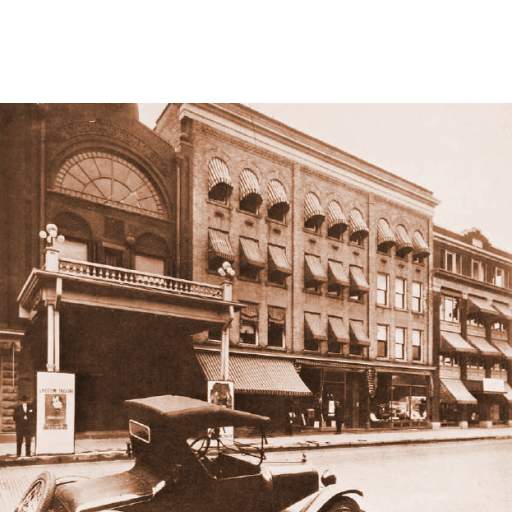
Lyceum Opera House
North Cayuga Street entrance to the former Lyceum Opera House, apparently taken shortly after its conversion to a motion-picture theater in 1924.
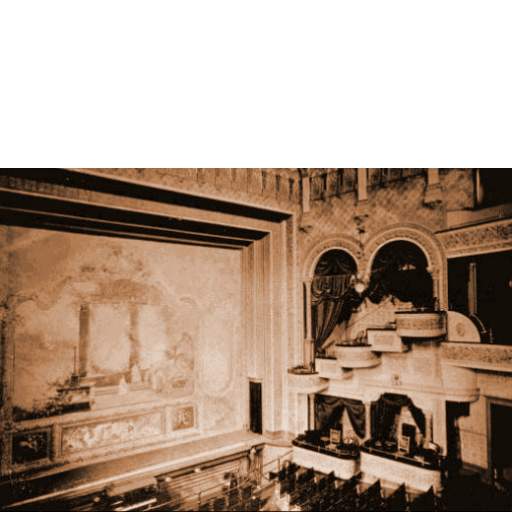
Lyceum Interior
Interior photograph of the Lyceum Opera House.
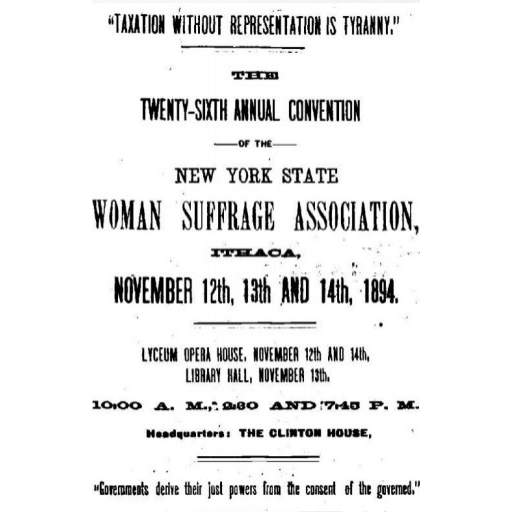
1894 Newspaper Advertisement
A Notice from the Ithaca Morning Herald promotes the 1894 convention of the New York State Woman Suffrage Association at Ithaca.
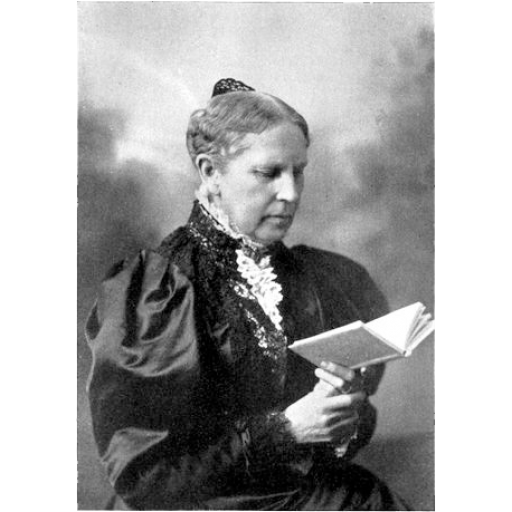
Mary S. Anthony
Mary S. Anthony, sister of Susan B. Anthony, was honored at the 1894 NYSWSA Convention.
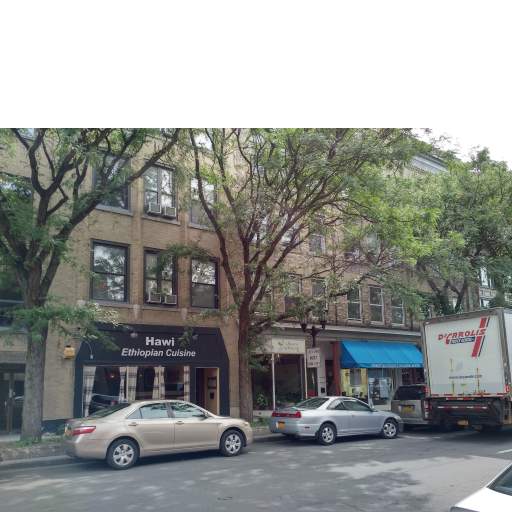
Lyceum Site Today
This building (viewed from across South Cayuga Street) replaced the Lyceum following its demolition in or shortly before 1934. The Ethiopian restaurant seen at left occupies the exact location of the Lyceum's box office.
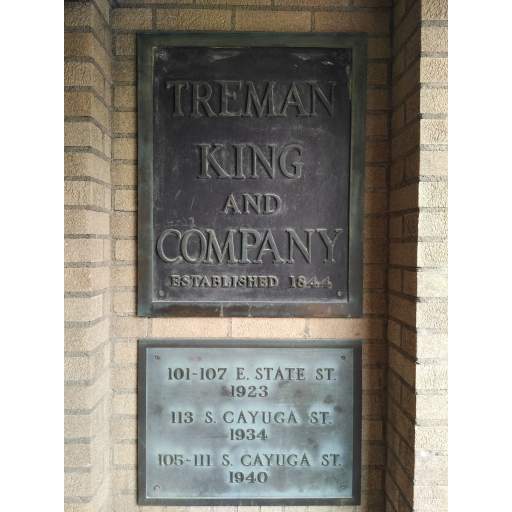
Commemorative Signage in Entryway
The entrance to the restaurant at 113 South Cayuga displays three commemorative items. This photo shows two of them. The topmost is a plaque from the Treman King and Company hardware store ("Established 1844"). The center plaque shows some organization's three successive locations between 1923 and 1940; it is presumed not to pertain to Treman King, which closed in 1939 and hence would not likely be relocating in 1940.
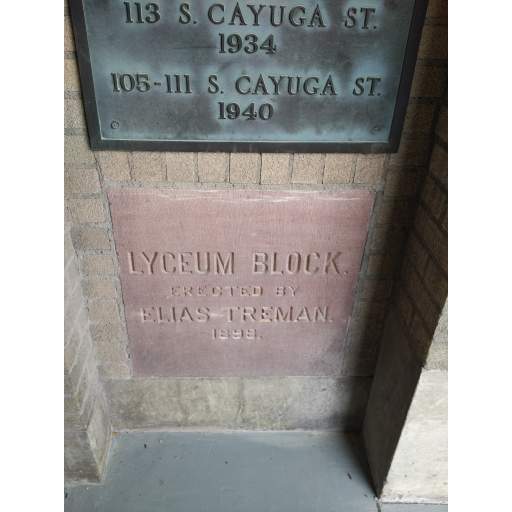
Commemorative Signage, Continued
The bottom item is a red sandstone block resembling a cornerstone marking the "Lyceum Block" and dated 1898. The Lyceum Opera House was erected in 1893; 1898 was however the year of co-owner Elias Treman's death. For that reason it is thought that this block is not a true cornerstone, but rather a memorial installed in tribute to the just-deceased Mr. Treman.
Associated Causes
Associated Historical Events
Twenty-Sixth NY State Suffrage Convention
November 12–16, 1894

